


|
|
|
|||||||||||||||
|
|
||||||||||||||||
|
|
|||||
|
|
Italy Ostia
The archaeological site of Ostia is located 15 miles (25 km) southwest of Rome, close to the town of Ostia at the mouth of the River Tiber on Italy’s west coast. It was, in Roman times, the seaport of ancient Rome and a major commercial centre and the first colony founded by ancient Rome.
The remains that have been discovered go back to the 4th century BCE although it is believed that it dates back to the 7th century BCE. Most of the remains that are visible today date from the 3rd century BCE. During the 1st century BCE it came under attack on a number of occasions. In 87 BCE, during the Civil War, it was attacked by Gaius Marius, the Roman General and Statesman in order to cut off the flow of trade to Rome. In 68 BCE, the town was sacked by pirates and set on fire, an act which caused Pompey the Great to raise an army, the purpose of which was to destroy the pirates, something that he achieved within a year. The town was then re-built and included protective walls. The town experienced significant development under Julia Caesar in order to provide a better supply of grain by the introduction of a new harbour. The town's development continued during the first century AD under Tiberius who was responsible for the construction of the first forum. Later the construction of a new harbour was carried out under Claudius. This harbour was to function until it became silted up necessitating the construction of a new one something that occurred under Trajan, this was completed in 113 AD. Trajan also constructed the harbour of Civitavecchia which is a short distance way so that took trade away from Ostia leading to the beginning of its decline. Although in the 3rd century AD it had a population of around 100,000 inhabitants, This decline quickened when it ceased to be an active harbour, although it remained as a retreat for the rich from Rome, even after the fall of the Roman Empire. Between the 6th and the 9th century, the decline continued until it was finally abandoned due mainly to the repeated sackings by Arab pirates. Following its abandonment, many of its stones were taken to be used in building projects. Excavations began in 1939. It is estimated that approximately one-third of the town has been excavated and geophysical surveys have found other significant areas containing structures that have still to be excavated. Entering Ostia visitors walk along the main road, the Via Ostensis which is paved with basalt blocks. Along the road are the tombs, which in Roman times were placed just outside the town gates. 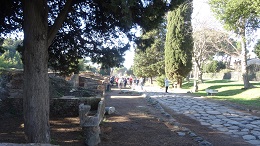 Visitors then come to the Porta Romana which was the monumental entrance to the city on the road from Rome. This was 5 meters wide and was let into the walls, although not much of this remains. 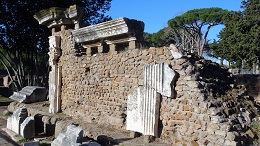 Continuing along the road, the Decumanus, which was the ancient main road is the Baths of Neptune, which was one of the many public baths in Ostia and certainly the largest and contains floors covered in mosaics. 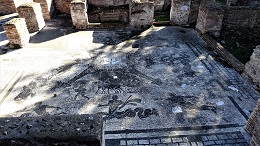 Public latrines can be seen and the one located along the street at the north side of the forum contained twenty seats and basins and channels for the removal of the water. Latrines
Before reaching the Forum is the large theatre, which was a place of social gathering as well as for entertainment this was built at the end of the 1st century during the rule of Emperor Augustus. It was later enlarged by Emperor Commodus (177-192 AD) and restored by Emperor Septimius Severus (193-211 AD). It has undergone restoration in modern times which still enables it to be used for functions today. 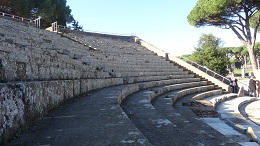 Theatre The theatre itself is built of masonry and has an external portico with arches and vaults constructed of concrete. Its main entrance runs off the Decumanus and is flanked by two monumental arches constructed in the 3rd century and dedicated to the emperor Caracalla (198-217 AD). These, in ancient times, would have been covered in stucco. Entrance to Theatre
The forum is the main square of the town and was the site of political and social gatherings. The square was surrounded by colonnades and was where the main temples and public buildings were located. Forum and Capitolium Temple
This included, on the north side, the Capitolium which was the main temple and dedicated to the Roman gods Jupiter, Juno, and Minerva. This was built of brick and originally had marble revetments although these are no longer there. Numerous other temples can be seen as well as places for the worship of Mithras, whose cult was particularly popular in the Roman Empire between the 1st to the 4th century. The town has a synagogue, which is the oldest synagogue to have been discovered outside of Israel. Dating from the reign of the emperor Claudius (41-54 AD) it continued to be used until the 5th century. A number of private houses displaying the wealth of many of the residents are on display. Contrasting this the site also contains apartment blocks, several stories high, and numerous taverns, some of which can be visited as can the shops. 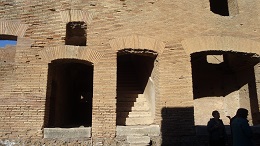 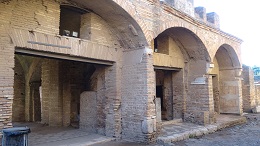 Being a port, the site has a number of storage and warehouse buildings, many of which can be visited, as can the remains of the hot food and drink shops and a number of bakeries. Hot Food and Drink Shop Bakery These show what life would have been like in those days as the bakeries provide an indication of the stages involved in the baking of bread, such as the grinding of corn, working the dough, the baking, and the sale of the bread over the shop counter can all be seen.
|
|
|||
|
|
|||||
All Photographs were taken by and are copyright of Ron Gatepain
| Site Map |
